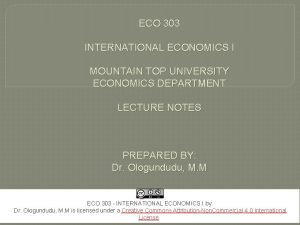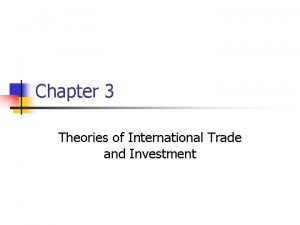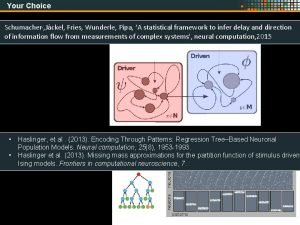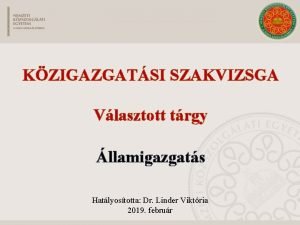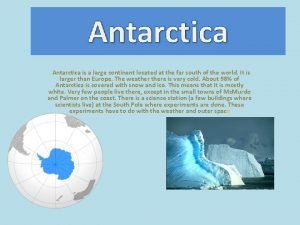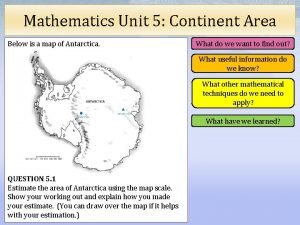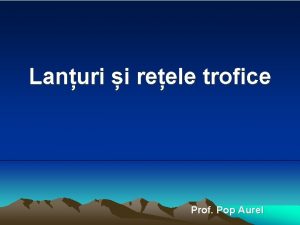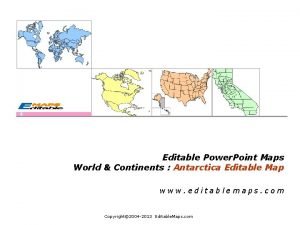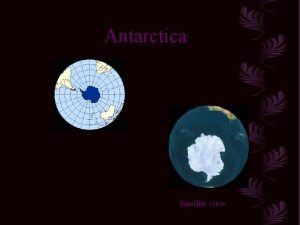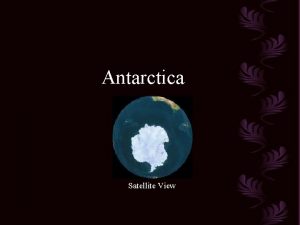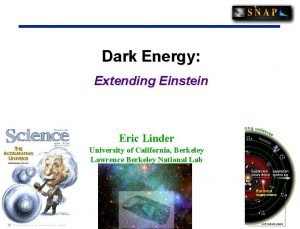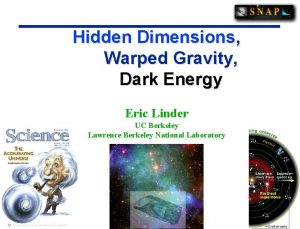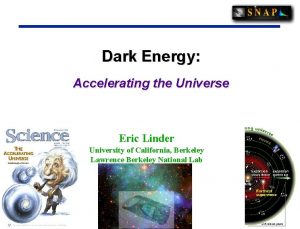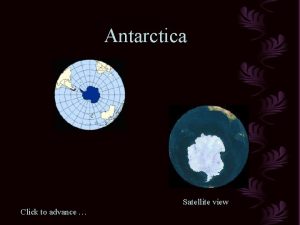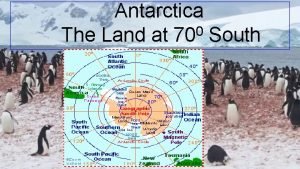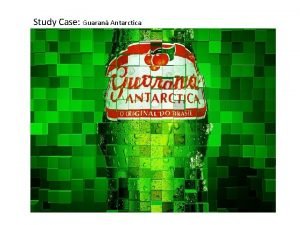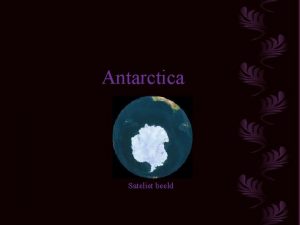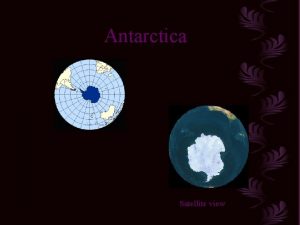Dark Energy in Dark Antarctica Eric Linder 21




















- Slides: 20

Dark Energy in Dark Antarctica Eric Linder 21 July 2009 Berkeley Center for Cosmological Physics, UC Berkeley & Berkeley Lab Institute for the Early Universe University, Seoul Ewha 11

Describing Our Universe Us New Stuff Old New Stuff Us STSc. I 95% of the universe is unknown! Now entertain conjecture of a time When creeping murmur and the poring dark Fills the wide vessel of the universe. - Shakespeare, Henry 22

Cosmic Coincidence Why not just settle for a cosmological constant ? We cannot calculate the vacuum energy to within 10120. 90 Butyears it gets Thinktoofunderstand the energywhy in For weworse: have tried 120 the asatthe level quantum At would most times is least 10 of times smaller“sea”. than we expect history, matter is either drowned or dry. –inand failed. We know there was an epoch of time varying vacuum once – inflation. Dark energy Matter Size=1/4 Size=1/2 Today Size=2 Size=4 33

On Beyond ! We need to explore further frontiers in high energy physics, gravitation, and cosmology. New quantum physics? Does nothing weigh something? Einstein’s cosmological constant, Quintessence, String theory New gravitational physics? Is nowhere somewhere? Quantum gravity, extended gravity, extra dimensions? 44

Beyond the Standard Model Consider CDM as Standard Model of Cosmology. Describe expansion history through model independent w 0, wa : accurate to 10 -3 level. Describe growth history distinct from expansion history effects through model independent growth index to test gravity: accurate to 10 -3 level. Describe early growth through calibration g* to test matter domination : accurate to 10 -3 level. This is theory framework -- we will need clever new observations to match. 55

Physics of Growth g(a)=( / )/a depends on the expansion history H(z) -- and gravity theory. 0 Expansion effects via H(a) or w(z), but separate effects of gravity on growth. g(a) ≈ exp { 0 ad ln a [ m(a) -1] } Growth index can describe extensions to general relativity (modified gravity). 66

The Nature of Gravity To test Einstein gravity, we need growth and expansion. Tension between distance and LSS mass growth reveals deviations from GR. Keep expansion history as w(a), growth deviation from expansion (mod. GR) by . Fit both simultaneously. Bias: gives deviations in growth from GR Huterer & Linder 2007 77

Extending the Growth Framework Consider In standard high-z matter dominated cases, g*=1. g*>1 allows enhanced growth. g*<1 allows suppression distinct from expansion and late time gravity effects. g* is window on Early Dark Energy, Early Gravity, Early Acceleration. Example: g* = 1 – 4. 4 e ( e=0. 023) Don’t ignore g*! 88

Observations Required To measure {w 0, wa, , g*} one needs expansion (distance) probes, e. g. Supernovae, CMB, and growth probes, e. g. Weak Lensing (CMB), Ly . ( )=0. 081, (g*)=0. 018 (+Ly 0. 042, 0. 006) Measurements of g* to 2% reveal: Early dark energy to ( e)=0. 005. Early gravity to G/G=1. 4%. Early acceleration to 1. 7% of a Hubble time. Next generation Dark Energy Missions can truly test the expansion/gravity/early time framework of cosmological physics! 99

Supernovae Surveys The cleanest method for measuring dark energy effects on expansion is Type Ia Supernovae. Next generation measurements must concentrate on systematics. P(>90% max bias) If there is unrecognized population drift, this biases cosmology. Where is it worst? 0. 5 1. 0 Transition Redshift 1. 5 10 10

Supernovae Surveys For z~1. 0 systematics, want NIR. Improvement in bias is linear in M down to 0. 01 mag. 2 (max bias) Where in wavelength is greatest improvement for dust correction systematic? Observer B, I, H bands (1, 5, 8). de Putter, Linder, Samsing 2009 11 11

What do we see in the CMB? COBE Planck WMAP “Ground. Pol” has 2. 5 x the resolution and 1/5 x the noise A view of the universe 99. 997% of the way back toward the Big Bang - and much more. 12 12

CMB and Dark Energy CMB provides a lever to break degeneracies CMB provides a key window on microphysics of dark energy - spatial fluctuations and sound speed cs 2 CMB Polarization (B-mode) is dominated at small angles by high redshift lensing by gravitational potentials of structure - hence high z structure formation. Polarization lensing “focuses” on the universe at z=1 -4, giving a window on early dark energy, and neutrinos. 13 13

Neutrinos and Dark Energy Neutrino masses, dark energy equation of state, and gravity all can suppress growth. Must fit all simultaneously to avoid bias. Abundance of galaxy clusters Huterer & Linder 2007 14 14

CMB Lensing and Growth Cosmic microwave background is sensitive to structure (so neutrinos, DE) through gravitational lensing of the CMB. Review: Lewis & Challinor 2006 Shuffling of photons smears the acoustic peaks and also induces power in the CMB polarization spectra. Detection of CMB lensing claimed by Smith et al. 2007, Hirata et al. 2008, Calabrese et al. 2008, Reichardt et al. 2009 Temperature data E-mode sim 15 15

Neutrinos and Dark Energy Must account for neutrino/dark energy degeneracy. cf. Lesgourgues et al. 2006, Smith, Hu, Kaplinghat 2006, Smith et al. 2008 CMBpol CMB lensing is a powerful tool for neutrino bounds. de Putter, Zahn, Linder 2009 16 16

Dark Energy and CMB Dangerous to fix neutrino mass (dashed) rather than marginalizing (solid). Overtight DE constraints. DE equation of state w(a) = w 0 + wa(1 -a) CMBpol + SN Filled contours fix m 17 17

CMB, Dark Energy, Neutrinos CMB Lensing will tightly constrain fundamental physics such as neutrino mass. With Supernovae, it can reveal dark energy properties. 18 18

Institute for the Early Universe Korea set up a “World Class University” program to advance international research collaboration. 3 Berkeleyites (Linder, Seljak, Smoot). 4 faculty at Ewha Womans University, Seoul. 6 postdocs hired, 4 more open, 3 new faculty open. Visit IEU at Ewha! Paris-Berkeley Dark Energy Cosmology workshop: systematics control, observations needed, ground+space 14 -18 Sep 2009 Paris, France darkenergy 09. in 2 p 3. fr 19 19

Antarctic Advantage Antarctic Surveys can make significant contributions in advancing Supernova Cosmology, with an emphasis on systematics control. NIR Observing ; Detailed Lightcurves. See talks by Helou, Huang, Kim, Nugent, Zheng Antarctic Surveys can make significant contributions in advancing CMB Lensing, with emphasis on low noise, high resolution, wide area. Dry, stable atmosphere ; Long observing runs. See talks by Smoot, Zhang. Plus structure survey for DE: see talks by Rhodes, Saunders, 20 Schlegel, Zhan. 20
 Dark matter and dark energy presentation
Dark matter and dark energy presentation Explain kravis and linder theory
Explain kravis and linder theory Ebba linder
Ebba linder Absolute advantage example
Absolute advantage example Glen linder
Glen linder Linder pipa
Linder pipa Dr linder
Dr linder How to dress for antarctica
How to dress for antarctica Where is antarctica located
Where is antarctica located Thin layers of volcanic ash act as excellent time markers
Thin layers of volcanic ash act as excellent time markers Cool antarctica.com
Cool antarctica.com Australia oceania and antarctica
Australia oceania and antarctica Estimate the area of antarctica using the map scale
Estimate the area of antarctica using the map scale Lant trofic campie
Lant trofic campie Antarctica outline map
Antarctica outline map Antarctica satellite view
Antarctica satellite view Satellite view of antarctica
Satellite view of antarctica Satellite photos of antarctica
Satellite photos of antarctica Antarctica is in which hemisphere
Antarctica is in which hemisphere Australia the pacific realm and antarctica
Australia the pacific realm and antarctica Invendável e imprestável
Invendável e imprestável

